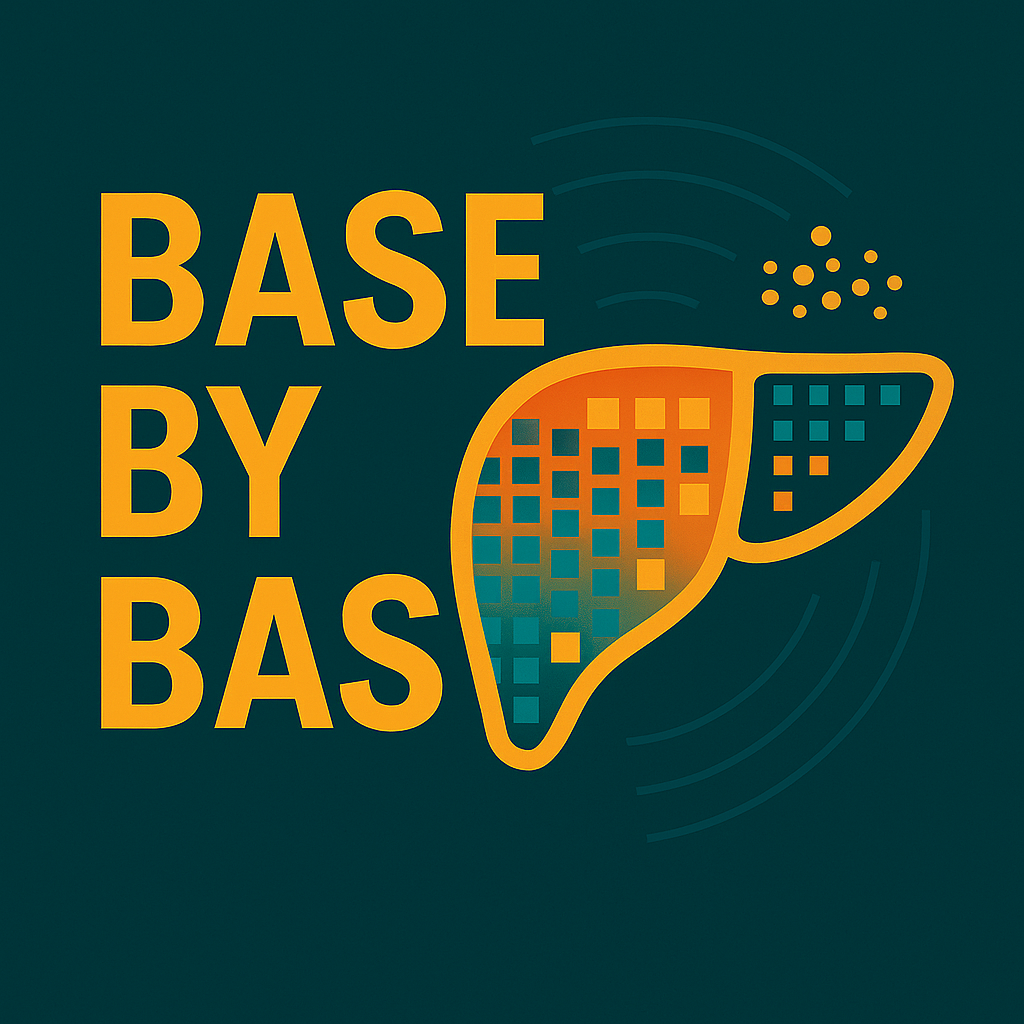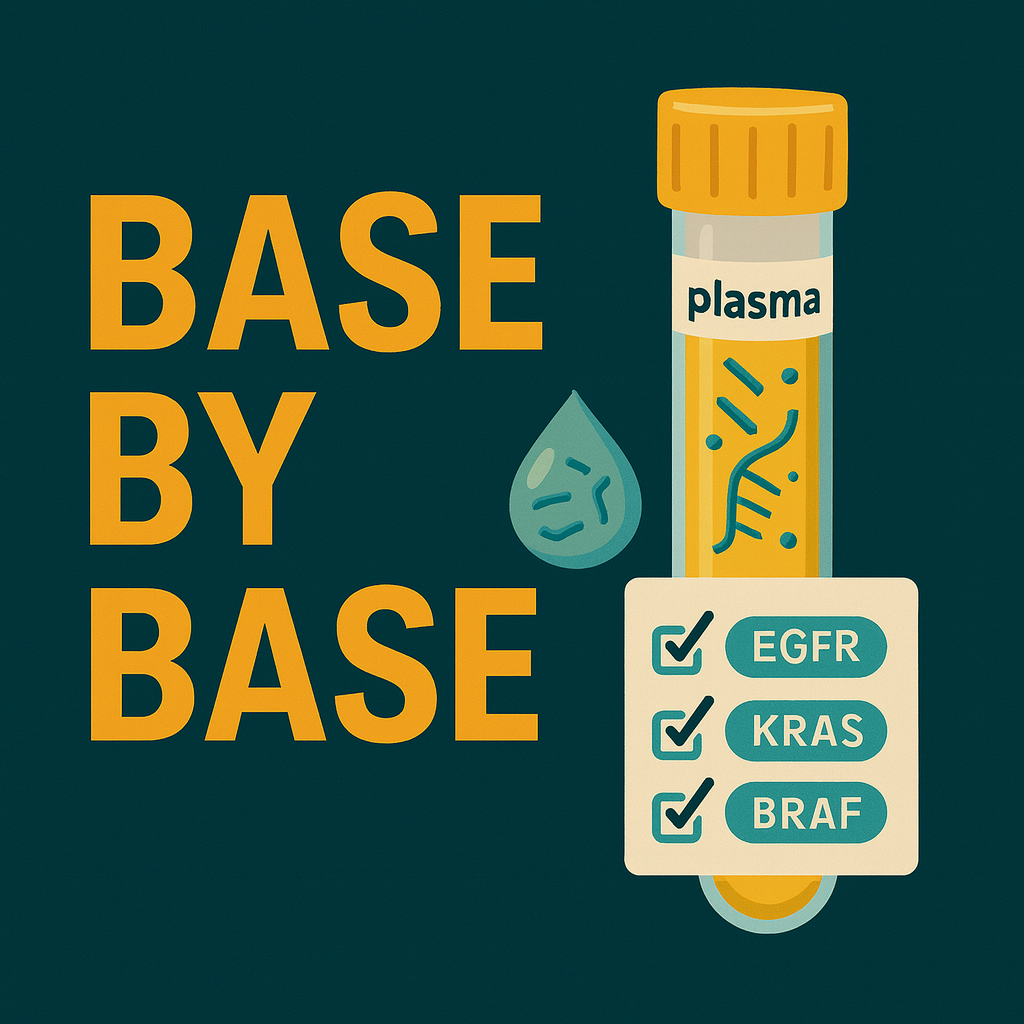Episode Transcript
[00:00:14] Speaker A: Welcome to base by base, the paper cast that brings genomics to you wherever you are.
Okay, so imagine for a moment a cancer treatment that's so precise, maybe even cunning, it basically forces cancer cells to hit their own self destruct button.
Yeah, we're talking about a strategy where the tumor poisons itself, you know, from the inside out. Sounds a bit like science fiction, right? But remarkably, new research is bringing us, well, incredibly closer to this actually being a reality. What if. What if we could exploit a cancer cell's own internal alarm system, sort of turn its defenses against itself? Today, we're diving deep into this concept called synthetic lethality. Picture it like this. You've got two separate weaknesses. Alone, each one might be harmless, maybe annoying, like, I don't know, a single flat tire, you can probably still manage. But put them together, say two flat tires, and suddenly, well, you're stranded. For a cell, that combination becomes fatal. It's not just about hitting one faulty gene. It's about finding these unexpected pairs of weaknesses that only become deadly together. Now, many of us know about BRCA1 and BRCA2 mutations. They're major players in lots of cancers, often making them really tough to treat. But this deep dive, it reveals a completely unexpected partner in crime, you could say. And maybe, just maybe, a powerful new way to target these difficult tumors. Get ready for a real aha, mom. Something that could genuinely shift how we think about cancer therapy.
[00:01:35] Speaker B: And today, we really want to celebrate the fantastic work of Roman M. Shabanon, Christopher J. Lord, Sophie Post Delvine, and, well, their very extensive team, their collaborations, spanning institutions like INSERM unit UMR981 at Gustavusi in France and the Institute of Cancer Research in London, have just profoundly advanced our understanding of how we can tackle these BRCA12 mutant cancers. It's truly a great example of international science working together and, you know, a potentially huge step for patients globally.
[00:02:02] Speaker A: Okay, so let's set the stage a bit for the scientific problem they're tackling here. A lot of us, we're familiar with BRCA1 and BRCA2 genes, right? Often linked to hereditary breast and ovarian cancers. When these genes are mutated, they can't do their job properly, which is repairing DNA damage. And that deficiency, that breakdown, can lead to cancer developing. It's like a fundamental problem with the cell's repair crew, leaving it, you know, vulnerable. So for decades, researchers have been hunting for these synthetic lethal partners for BRCA12 mutations. The most famous example, of course, is PRP inhibitors. For anyone who might need a Quick refresher. Could you maybe walk us through what made PRP inhibitors such a. Well, such a breakthrough for these BRCA mutant cancers? And also, why is finding new approaches still so critical?
[00:02:46] Speaker B: Oh, absolutely. Yeah. PRP inhibitors were a real game changer. They directly exploit that.
That existing DNA repair problem in BRCA mutant cells. Think of it like this. BRCA mutant cells, they already have a broken primary DNA repair pathway. PRP inhibitors then come in and block a secondary repair pathway. So it overwhelms the cancer cell with so much unrepaired damage that it just. It can't survive. Yeah, it's like. Well, it's like cutting off their last escape route, essentially. They really revolutionized treatment for many patients, extending lives, offering real hope. But, and this is a big but. Cancer cells are incredibly adaptable. They can and often do become resistant to POP inhibitors over time. They find these clever little workarounds to bypass that DNA damage problem. So the search for new vulnerabilities, different vulnerabilities, is absolutely crucial. We just need more tools in the toolbox for when that first line of defense eventually faces resistance, right?
[00:03:38] Speaker A: Exactly. And that leads us perfectly to 8R1 stepping into the spotlight here before we get into its first, frankly, surprising role in this story. What exactly is ADAR1?
[00:03:48] Speaker B: Okay. ADR1.
It stands for adenosine daemonase acting on RNA1. It's a. Well, it's a really fascinating RNA editing enzyme. Its main job is to convert adenosine to inosine. But specifically in double stranded rna, we call that process a RNA editing. You can sort of think of it as a crucial molecular editor, subtly tweaking the genetic constructions carried by RNA molecules. What's also really important to know is that 8R1 comes in two main forms or isoforms. There's ADAR1P150. That one's mostly sound out in the cytoplasm, and it's critical for stopping autoimmune responses by editing that double stranded RNA. Then there's ADR1. P110. This one stays in the nucleus, and its job is more about maintaining genome stability by resolving these complex structures called R loops. R loops. Okay, that sounds intriguing. Can you quickly demystify that a bit? What is an R loop and why does it matter here? Yeah, great question. So imagine your DNA, right, that tightly wound double helix. Like a twisted ladder, An R loop forms when an RNA strand actually sticks really strongly to one of the DNA strands in that helix.
It kind of pries the ladder apart locally, creating this weird three strand Structure DNA RNA hybrid plus the other DNA strand. And the problem is these R loops can physically block crucial cellular processes like DNA repair and replication. They cause a lot of stress for the cell.
Okay, so crucially, one of Adrian's main roles is to prevent our immune system from freaking out over our own genetic material. Without Adrian's editing, some of our cells internal rna, especially that double stranded rna, could look like viral genetic material to our internal sensors.
Yeah. Triggering a really harmful immune response against perfectly healthy tissue. This specific function, this sort of self versus non self recognition at the RNA level is absolutely key to understanding the paper's, well, quite remarkable findings because it turns out that very protective mechanism can actually become a deadly weakness for certain cancer cells. And it's worth noting too, Adar 1 was already on the radar as a potential target in immuno oncology. Inhibiting it could make tumors more visible to the immune system.
But the problem was we didn't really have a reliable biomarker. Something to tell us which patients would actually benefit.
Until maybe now.
[00:06:01] Speaker A: Okay, so this is fascinating. With this very specific potential vulnerability, how did the researchers even begin to systematically zero in on 8R1? I mean, what was their process? They weren't just guessing, right?
[00:06:12] Speaker B: No, definitely not guessing. They were very systematic. They started with a focused small interfering RNA screen and SERNA screen. This is a powerful technique where you essentially silence genes one by one very specifically to see what effect it has. Their goal was to find synthetic lethal interactions with specifically looking at genes involved in pattern recognition receptors. Those are the cells internal viral detectors, basically in BRCA1.
[00:06:36] Speaker A: Right. And they used a particularly clever setup called isogenic systems. Can you explain that?
[00:06:41] Speaker B: Yeah, that's a key part. Isogenic means they use cell lines that are genetically identical except for the specific gene they're interested in, in this case, BRCA1 or BRCA2. So they could do these really clean comparisons between BRCA mutant cells, and they're basically identical but repaired counterparts.
[00:06:57] Speaker A: Ah, okay.
[00:06:58] Speaker B: For example, they used SEO149 cells, which are a model for triple negative breast cancer. And then they also used a version of those same cells where the BRCA1 function had been restored, the reverted clone. This lets you subtract out all the other genetic noise and really pinpoint effects linked just to that BRCA status.
[00:07:15] Speaker A: Okay, that makes sense. Very clean. And it sounds like they didn't just stop there.
[00:07:18] Speaker B: Oh, not at all. The, the breadth and rigor here are really impressive. Beyond those initial screens, they used a whole battery of different approaches to really nail down their Findings. They used CRISPR gene editing to make precise changes to the 8R1 gene itself. They also used something called doxycycline inducible short hairpin RNA or HRNA, which let them turn 8R1 expression on and off controllably. Now, we really need to emphasize the penetrance here. This wasn't just something they saw on one or two cell lines. They tested this brks 12er1 synthetic lethality across. Get this, 10 independent models.
[00:07:53] Speaker A: 10? Wow.
[00:07:54] Speaker B: Yeah. 10 including different human cell lines, mouse cell lines covering different cancer types too, like triple negative breast cancer, colorectal ovarian. This really drives home that it's likely a robust biological effect, not just some fluke in one specific system.
[00:08:09] Speaker A: Ten independent models, that's definitely impressive for lab work. But then they took it even further, didn't they, beyond the cell cultures?
[00:08:14] Speaker B: They did. And this is where it gets, well, really compelling. I think they validated the synthetic lethality in vivo. So in a whole living organism, they use zebrafish embryos. Donna Rario.
Yeah, they knocked out both the BRICA2 gene and the ETR1 gene in these developing zebrafish. And what they found is that this double knockout was embryonically lethal. The embryos couldn't develop.
This provides really strong support that this synthetic lethal interaction has profound biological consequences in a living system, not just in a petri dish. It adds a whole other layer of confidence. And then to really bridge towards the clinic, they looked at actual patient samples.
They analyzed AR1 expression and activity in patient derived samples, specifically from triple negative breast cancer and prostate cancer. They even used patient derived xenografts, PDXs.
[00:09:03] Speaker A: Ah, the PDXs where you grow human tumors in mice.
[00:09:06] Speaker B: Exactly. It's a much more realistic model of human disease. And they threw a whole suite of techniques at this RNA seq to measure that AI RNA editing level, which tells you about 8R1 activity, immunofluorescence, to actually see things like DNA damage markers and those R loops inside the cells, Western blots for proteins, rt, QPCR for gene expression. They really covered all the bases plus functional experiments like they deliberately overexpressed an enzyme called RNase H1, which degrades R loops to see if that rescued the cells. Or they used drugs to block pathways downstream. This comprehensive approach just builds such a solid case.
[00:09:42] Speaker A: Right, so after all that meticulous work validating it across cell lines, zebrafish patient samples, what was the big headline, the game changing discovery?
[00:09:51] Speaker B: Okay, the first pig headline. They robustly consistently found that BRCA12 mutations and inhibiting AR1 are synthetically lethal. Bottom line, blocking ADR1 selectively kills cancer cells that have those BRCA1 or BRCA2 mutations. And crucially, they saw this effect both in the lab dishes and in the zebrafish. So that's just a hypothesis. They observed it happening again and again.
[00:10:13] Speaker A: And they were able to pinpoint which specific part of ADR1 was responsible for this effect.
[00:10:18] Speaker B: Yes, exactly. They narrowed it down. It's specifically the ADAR1 P150 isoform, the one main the cytoplasm and its DNase activity, its ability to actually edit RNA that are essential for this synthetic lethality. So it's not just the presence of 8R1 protein, it's that specific form and its RNA editing function that are absolutely critical here.
[00:10:38] Speaker A: Okay, so we know it happens. Blocking 8 R1 kills BRCA mutant cells. Now let's get into the really fascinating part, the why and the how. What's the actual mechanism driving this self destruction?
[00:10:50] Speaker B: Right. This is where it gets really interesting. The findings sort of peel back like layers of an onion. First they found something quite striking. 8R1 activity is actually cranked up in BRCA12 mutant cancers. Compared to normal cells or BRCA proficient cancers, they saw higher levels of that 8R1 P1.50 protein in patient tumor samples from TNBC. And in those prostate cancer PDXs with BRCA2 mutations, they saw significantly higher A to RNA editing activity.
This is a really key observation. It suggests these cancers have become in a way addicted to ADAR1. They're already relying on it heavily for survival.
[00:11:25] Speaker A: Ah, so they've created their own vulnerability.
[00:11:27] Speaker B: Exactly. They've developed a dependency in Achilles heel.
[00:11:30] Speaker A: Okay, so they're already sort of leaning on Adar 1. When you kick that crutch away by inhibiting it, what actually causes the cell to collapse?
[00:11:36] Speaker B: That brings us back to the R loops. Remember those DNA RNA hybrid structures?
[00:11:41] Speaker A: Right.
[00:11:41] Speaker B: When you silence 8R1 in these already stressed BRCA12 mutant cells, you get a big pile up of these R loops. And this pile up leads directly to increased DNA damage. They can see markers like gamma H2AXI lighting up and signs of replication stress. The cells just can't handle it. This genomic instability, this damage overload is a major reason why the cancer cells die. It's like the combined stress just pushes them over the edge. But here's the coolest part. The mechanism the authors term autocrine interferon poisoning. This is really the central aha moment.
[00:12:12] Speaker A: Autocrine interferon poisoning.
[00:12:14] Speaker B: Okay. Yeah. So Those accumulated R loops sitting there in the cytoplasm, they trigger activation of specific sensors. These cytosolic nucleic acid sensing pattern recognition receptors, or PRRs. Think names like RIGI1, MDA5, PKR, CGAs. These are the cell's internal alarm bells. Usually looking for viruses.
[00:12:34] Speaker A: Okay.
[00:12:34] Speaker B: But here they get triggered by the cell's own accumulating R loops, leading to a type I interferon response and an integrated stress response. All happening inside the cancer cell itself.
[00:12:45] Speaker A: So tumor cell autonomous. That means this whole alarm system and response is contained within the cancer cell. It's not relying on external immune cells coming in.
[00:12:54] Speaker B: Precisely. It's an internal meltdown. This internal immune like response, basically mimicking a viral infection within the cancer cell, becomes incredibly toxic, specifically to these BRCA12 mutant cells. It's like the cancer cell accidentally triggers its own internal security system. And that system, it. It's a really fascinating, almost diabolical mechanism. And crucially, they backed this up with solid experiments. Remember RNase H1, the enzyme that chews up R loops? When they over expressed RNase H1, it reversed the synthetic lethality. The cells survived better. DNA damage went down, the interferon response calmed down.
[00:13:29] Speaker A: Wow.
[00:13:29] Speaker B: Similarly, if they use drugs to block that interferon signaling pathway, or if they silence the PR sensors themselves and it also stopped the eight OR one dependency. This gives really strong evidence that this unique autocrine interferon poisoning mechanism is really what's driving this specific synthetic lethality.
[00:13:46] Speaker A: Okay, so let's unpack the implications here. This sounds, well, pretty significant. It seems like a fundamentally new angle on synthetic lethality, doesn't it?
[00:13:54] Speaker B: It really does. It's conceptually quite novel. Think about PRP inhibitors. While they work directly on DNA repair, their full effect often involves interplay with the external immune system, like T cells, helping clear out the damaged cancer cells.
But this 8, R1, BRCA12 synthetic lethality appears to be largely tumor cell autonomous. It's leveraging the cancer cell's own internal intrinsic immune sensing pathways. It's a totally different way in.
[00:14:19] Speaker A: And a huge implication of that is that the BRCA12 mutation itself becomes a really strong predictive biomarker. Right. It tells you which tumors should be sensitive to ADR1 inhibition.
[00:14:29] Speaker B: Exactly. That's potentially a massive step forward for patient stratification.
If this holds up, you could test a patient's tumor for BRCA1 or BRCA2 mutations. And if they're present, you'd have a strong rationale to consider an ADR1 inhibitor. Knowing who is Likely to respond is just critical for effective precision oncology.
[00:14:49] Speaker A: So connecting this to the bigger picture, what's the potential clinical impact?
[00:14:53] Speaker B: Well, the potential is pretty significant.
ADR1 targeting drugs could be a real game changer. Especially maybe for those BRCA12 mutant cancers that have already developed resistance to standard treatments like platinum chemo or even those PRP inhibitors.
[00:15:07] Speaker A: Giving them a new option.
[00:15:08] Speaker B: Precisely. It offers a completely fresh line of attack for these really difficult to treat cases where options are often limited. And it also opens up possibilities for new combination therapies. You could imagine maybe combining an ADR1 inhibitor with, say, a lower dose of another DNA damage response inhibitor. The idea being you might get a synergistic effect that's more potent but potentially less toxic than some current combinations. That would be a huge win for patients.
[00:15:36] Speaker A: That sounds incredibly promising. But of course, with any exciting new research, there are always going to be limitations or next steps needed. What are some of those here?
[00:15:45] Speaker B: You're absolutely right. It's still early days in some respects. While they clearly showed r loops and PRR activation are key, pinpointing exactly which PRRs are the most important contributors might need more work.
Also, understanding the precise nature of the R loops, where they form in the genome, what specific sequences are involved, that needs deeper investigation too. And then there's the big practical drug development.
While this research provides a strong rationale, there aren't Many highly selective potent 8R1 small molecule inhibitors ready for the clinic just yet. So there's a real need to accelerate the development of those drugs to actually translate this science.
And one other really important question this raises is could this synthetic lethality extend beyond just BRCA1 and BRCA2 mutations? Could it apply to other defects in homologous recombination repair? Or maybe to cancers exhibiting a more general BRCA anus phenotype?
[00:16:37] Speaker A: BRCA nus, meaning they act like BRCA mutant cancers even without the specific mutation.
[00:16:43] Speaker B: Exactly. They have similar repair defects due to other gene mutations. If this 801 dependency applies more broadly to BRCNs, that would significantly widen the potential patient population. Who could benefit? That's a key area for future research.
[00:16:55] Speaker A: So to boil it down, this research really uncovers a fascinating novel vulnerability in BRC12 mutant cancers. This unexpected dependence on the 8R1 enzyme. And by targeting 8R1, the idea is you can trigger the self destructive autocrine interferon poisoning right inside the cancer cells themselves. It offers a potentially powerful and quite different new strategy for treatment. So thinking forward, what does this really mean for the future of precision oncology could really understanding a cancer cell's internal alarm systems, you know the very defenses it relies on, be the key to unlocking completely new ways to treat cancer, essentially turning a tumor's own survival mechanisms against itself. This episode was based on an Open Access article under the CCBY 4.0 license. You can find a direct link to the paper and the license in our episode description. If you enjoyed this, follow or subscribe on your podcast app and leave a five star rating. If you'd like to support our work, use the donation link in the description. Thanks for listening and join us next time as we explore more science base by base.




